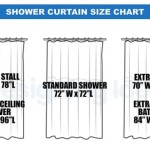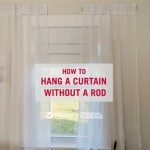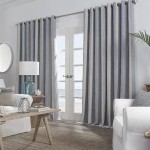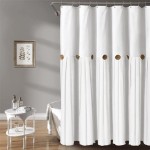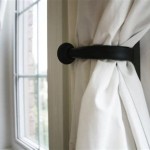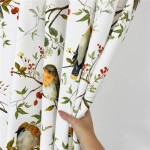Blue and White Striped Blackout Curtains: A Comprehensive Guide
Blue and white striped blackout curtains are a popular choice for homeowners and renters seeking to combine aesthetic appeal with functional benefits. These curtains offer a classic design element while simultaneously providing effective light blockage, promoting better sleep, and enhancing privacy. Understanding the various aspects of these curtains, from materials and construction to design considerations and practical applications, can assist in making informed purchasing decisions.
The combination of blue and white in a striped pattern represents a versatile design that complements numerous interior styles. The blue, often associated with calmness and serenity, adds a soothing element to a room, while the white provides brightness and enhances the sense of space. The striped pattern, whether vertical or horizontal, introduces visual interest and can contribute to the overall aesthetic of the room. Blackout curtains, primarily designed to block light, play a critical role in creating a comfortable and controlled environment within a living space.
Material Composition and Blackout Capabilities
The effectiveness of blue and white striped blackout curtains in blocking light depends heavily on the materials used in their construction. Several types of fabrics are commonly employed, each offering varying levels of light blockage and insulation. These include polyester, microfiber, and specially coated fabrics.
Polyester is a widely used synthetic material known for its durability, affordability, and ease of maintenance. Blackout curtains made from polyester often incorporate multiple layers or a tightly woven construction to minimize light penetration. While polyester alone may not provide complete light blockage, it serves as a good base material that can be enhanced with additional treatments or linings.
Microfiber is another synthetic fabric characterized by its fine fibers and soft texture. Similar to polyester, microfiber blackout curtains typically require multiple layers or a dense weave to achieve effective light blockage. The density of the fabric plays a crucial role in determining its ability to block out sunlight and artificial light sources. Microfiber curtains are also relatively wrinkle-resistant, contributing to a cleaner and more polished appearance.
Specially coated fabrics represent a more advanced approach to blackout curtain construction. These fabrics are treated with a coating, such as acrylic or polyurethane, on the back side to create a complete barrier against light. The coating effectively blocks light from passing through the fabric, providing a high level of light blockage. Coated blackout curtains are often more effective than those made solely from polyester or microfiber, especially in situations where near-total darkness is desired.
The weave density and layering of the fabric also play a significant role in blackout capabilities. Tightly woven fabrics with multiple layers are more likely to block light effectively than loosely woven, single-layer fabrics. Some blackout curtains incorporate a separate blackout lining, which is attached to the back of the decorative fabric to enhance light blockage. This lining is usually made of a dense, opaque material that prevents light from passing through.
It is important to note that even the most effective blackout curtains may not achieve complete light blockage. Gaps around the edges of the curtains, where they meet the wall or window frame, can allow some light to enter the room. To minimize light leakage, consider using wider curtains that extend beyond the window frame or installing them with wraparound curtain rods.
Design Considerations and Aesthetic Integration
Beyond their functional benefits, blue and white striped blackout curtains contribute significantly to the aesthetic of a room. The design, pattern, and color combination can influence the overall atmosphere and complement the existing décor. Various design considerations should be taken into account when selecting these curtains.
The width and spacing of the stripes are key elements in the design. Wider stripes create a bolder, more graphic statement, while narrower stripes offer a more subtle and refined look. The spacing between the stripes also affects the overall visual impact. Closely spaced stripes create a denser pattern, while widely spaced stripes offer a more open and airy feel. The choice depends largely on personal preference and the desired aesthetic for the room.
The orientation of the stripes, whether vertical or horizontal, can influence the perception of the room's dimensions. Vertical stripes tend to create the illusion of height, making the room appear taller. Horizontal stripes can make a room seem wider. Considering the room's existing proportions and the desired visual effect can guide the selection of stripe orientation.
The specific shades of blue and white used in the curtains can also impact the overall aesthetic. Lighter shades of blue, such as sky blue or powder blue, create a brighter and more airy atmosphere. Darker shades of blue, such as navy blue or royal blue, offer a more sophisticated and dramatic look. The choice of white, whether pure white or off-white, can also affect the overall tone. Off-white shades can add warmth and softness to the room.
The style of the curtains, such as pleated, grommeted, or rod pocket, can also influence the overall aesthetic. Pleated curtains offer a more formal and traditional look, while grommeted curtains provide a more modern and streamlined appearance. Rod pocket curtains are a simple and versatile option. The choice of style should complement the existing décor and the desired level of formality.
Consider the existing color palette and décor of the room when selecting blue and white striped blackout curtains. The curtains should complement the existing furniture, wall color, and accessories. Coordinating the curtains with other elements in the room can create a cohesive and harmonious design scheme.
Practical Applications and Benefits
Blue and white striped blackout curtains offer a range of practical applications and benefits beyond their aesthetic appeal. These curtains are particularly useful in bedrooms, nurseries, and home theaters, where light control is essential. They also provide benefits related to energy efficiency and noise reduction.
In bedrooms, blackout curtains promote better sleep by blocking out sunlight and artificial light sources. Light exposure can interfere with the body's natural sleep-wake cycle, making it difficult to fall asleep and stay asleep. Blackout curtains create a darker and more conducive environment for sleep, helping to improve sleep quality and duration. This is particularly beneficial for individuals who are sensitive to light or who work night shifts.
In nurseries, blackout curtains are essential for creating a comfortable sleep environment for infants and young children. Babies and toddlers often require daytime naps, and blackout curtains can help to block out distracting light and create a soothing atmosphere. A darkened room can also help to regulate a child's sleep patterns and promote better sleep habits.
In home theaters, blackout curtains enhance the viewing experience by reducing glare and improving contrast. Blocking out ambient light allows for a clearer and more immersive viewing experience, particularly when watching movies or playing video games. Blackout curtains can transform a living room into a dedicated home theater space.
Blackout curtains also contribute to energy efficiency by providing insulation. The dense fabric and multiple layers help to reduce heat transfer through windows, keeping the room cooler in the summer and warmer in the winter. This can lead to lower energy bills and a more comfortable indoor environment. Blackout curtains can also help to protect furniture and flooring from fading caused by sunlight exposure.
In addition to light and temperature control, blackout curtains can also provide some degree of noise reduction. The dense fabric can help to absorb sound and reduce the transmission of noise from outside. While blackout curtains are not as effective as dedicated soundproofing materials, they can contribute to a quieter and more peaceful indoor environment, particularly in noisy urban areas.
The ease of maintenance of blue and white striped blackout curtains is important for long-term use. Materials like polyester and microfiber are generally easy to clean and maintain. Most blackout curtains can be machine washed or spot cleaned as needed. Following the manufacturer's instructions for cleaning and care can help to prolong the life of the curtains and maintain their appearance.

84 Inch Blackout Irregular Mini Striped Kids Panel Blue Pillowfort

Vhc Brands Sawyer Mill Blue White Ticking Stripe 40 In W X 84 L Blackout Curtain 83578 The Home

Driftaway Chris Vertical Striped Pattern Linen Textured Lined Thermal Insulated Blackout And Room Darkening Grommet Window Curtains For Farmhouse

Vertical Stripes Light Blue And White Blackout Curtain By Quinnhopp Society6

Vhc Brands Sawyer Mill Blue White Ticking Stripe 40 In W X 84 L Blackout Curtain 83578 The Home

Navy Blue White Cabana Modern Wide Horizontal Stripe Curtains Pinch Pleat 84 96 108 120 Long Optional Blackout Or Cotton Lining

French Stripes Farmhouse Curtains 1 Piece Striped Blue And White Coastal Country Blackout Grain Sack Lines Etsy

Navy Blue And White Stripes Blackout Curtain By Ron Eric Society6

Exclusive Fabrics Furnishings Flambe Blackout 50 X 108 Curtain Panel Blue

Navy Blue Square Window Curtains For Teen Bedroom 42 Wx84 L Black White Grey Geometric Geometry Striped 30 50 Blackout

